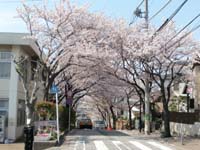- Yokohama-shi Top Page
- Konan Ward Top Page
- Introduction of the ward
- Cultural assets in Konan Ward
- Folk tales
- Seki, the political center, and the cherry blossoms in Konan.
Here's the text.
Seki, the political center, and the cherry blossoms in Konan.
Last Updated December 13, 2024
Folk tale of Konan Ward
The political center "Seki" and the cherry blossom Konan in Konan.
When the Edo Shogunate ruled, the area of Noba, Nagatani and Serigaya now in Konan Ward was Sagami country, and the area of Kamiooka, Sasashita, Okubo and Hino was Musashi country.
"It was like a hiya, I thought everyone Kanagawa Prefecture was Sagami country."
The politics of the Chongmage samurai of the Edo Shogunate were defeated by the forces of the "Kurofune" who came from the United States and those who wanted to return the politics of the Shogunate to the politics of the Emperor. A song that expresses the black ship at this time.
"Taihei's sleep, Kamikisen (steam boat)
I can't sleep at night with only four (boats)."
What a song is sung, but Kamikisen is a kind of good tea, but you think about the meaning of the song, and I think it is true.
In this way, a new Meiji government was established, leaving Musashi and Sagami countries, called "Abandoned feudal prefectures," and Konan Ward became "Kuragi-gun" except for Noba and Nagatani.

Tojuin
Therefore, the Kuragi-gun government office is located near Tojuin in Seki, Sasa Shimomura, followed by a registration office for schools, post offices, police department, land and houses, which became the center of politics and education.
It is said that in the Nara era, there was a government office called Kuragi-gun government office near the shrine of Amaterasu Ogami in Sasashita.
Therefore, the Meiji government, which abolished the samurai, adopted a system in which boys who turned 20 years old were soldiers, so those who came to the conscription inspection and "people who came to the government office due to errands were busy.
Along with that, it was very busy with daily necessities, miscellaneous goods, restaurants, inns, barbershops, manpower shops, transporters, etc., and people who came and went "pee" and said that the rice in the rice fields on the roadside did not stick to ears.
The house around here was called by the trade name. "Manjuya, Zaruya, Tofuya, Senbeiya, Getaya, Ishikawaya", etc.
That's because Kuragi-gun at that time was a large area from around Yokohama Station to Kanazawa, and the Seki-no-mura flourished at the center of it was the center of Kamakura Road and Kanesawa Road.
There's another interesting story.
At the beginning of the Showa era, when there was a problem of relocation of Kusaka Elementary School, a telegram arrived from the city's education section manager. It's a long time ago when there were few telephones.
"Asuyukanenukidokucho"
Well, tomorrow's promise is that the chief of education will come today. I gathered people in a hurry. I'll wait and I'll never come.
When the officers fly a bicycle to the government office to see the situation and talk about the translation of the matter, no, it is,
If you add "," to the nu of "Asyucarene ...", it means "I can't go tomorrow, education section manager". All of them were disappointed and disappointing, and broke up with a laugh.
In addition, there is a story about "Sakura in Konan".
Sakuramichi, 1,200 meters from the entrance of Sakuramichi next to the Konan Ward Office to the back gate of the park cemetery, and Sekisaka, 700 meters from the Sasashita and Kamariya Roads, has become a famous spot for cherry blossoms.
Yokohama became a big city, the population increased steadily, and as it became necessary, this was chosen as a reasonable cemetery, and in 1931 we decided to build a cemetery here by making good use of the mountains.
A farmer who has the land equivalent to the approach to the cemetery donated the approach site to the city, and the Hino Park Cemetery was completed in 1933.
As one of the commemorations, the local Neighborhood Associations and the youth group, who were active at the time, decided to plant cherry blossom seedlings of Yoshino cherry tree on the approach to Sakuramichi and Sekisaka.

Cherry blossoms in Konan (Sakuramichi)
It was planned to be planted on both approaches, but when the Sakuramichi side was planted and the Sekisaka side was planted from above, the seedlings ran out along the slope, and finally ended there. That's why the row of cherry trees is not connected from below.
This cherry tree will be just about 60 years old, but there were many things during that time.
During the Pacific War, it was said that the shade of trees was not disturbed by the food increase, that it was about to be cut down to compensate for the lack of fuel, and in recent years it was treated as a disturbance of traffic and sunshine rights. However, thanks to local understanding and preservation activities, the "Konan Cherry Blossom Festival" is also held, and you can still enjoy wonderful cherry blossom viewing.
The stone of the monument engraved with "Sakura of Yokohama Famous Konan" at the corner of the Sekisaka intersection is originally based on the torii gate of Sasa Shimoshimmei Shrine. You can see traces of the efforts of the local people.
Contact
It is a story recorded in "Old Story of Hometown Konan 50 Episode".
Each folk tale is available free in principle only for non-commercial purposes.
Please contact the Konan History Council for details.
Konan History Council homepage (outside site)
Inquiries to this page
Konan Ward Ward Administration Promotion Division
Telephone: 045-847-8327
Telephone: 045-847-8327
Fax: 045-846-2483
Email address: kn-kusei@city.yokohama.lg.jp
Page ID: 565-187-326












